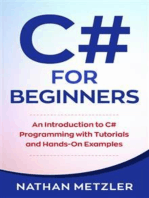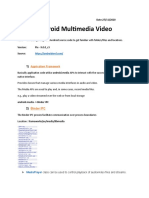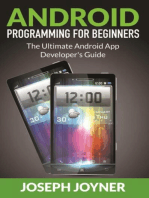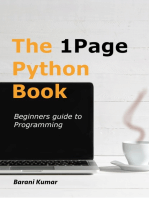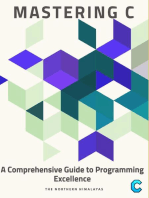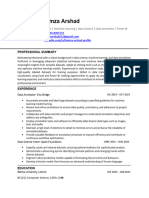Android MultiMedia FrameWork
Uploaded by
Atharva MahabareAndroid MultiMedia FrameWork
Uploaded by
Atharva MahabareBreakdown of the Android Multimedia Framework Text:
Android Development, Multimedia Framework:
● This section explains the components that make up the system for handling multimedia
(audio/video) on Android devices.
● It includes:
○ Multimedia applications: These are the apps that use multimedia, like music players or
video editors.
○ Multimedia framework: This is a set of tools that developers can use to build multimedia
features into their apps.
○ OpenCore engine: This is the core software that processes multimedia data (like decoding
videos).
○ Hardware abstraction layer: This layer translates between the multimedia framework and
the physical audio/video hardware on your device.
● The goal of the multimedia framework is to provide a reliable and consistent way for Java
code (the programming language used for most Android apps) to interact with multimedia
features.
Components of the Multimedia Framework:
● The framework uses several core libraries, including:
○ libmediajni: This library helps Java code call native C code (like the Libmedia library).
○ libmedia: This is the main library that handles communication with the media server.
○ libmediaplayservice: This library is likely responsible for managing playback functionalities.
How it Works:
● There are two main processes involved:
○ Java application: This is your multimedia app.
○ Media Server: This is a system process that handles the actual multimedia processing.
● Here's a step-by-step breakdown of how it works:
1. Your Java application tells the framework (through JNI) what media to play (e.g., a song
or video file).
2. The framework calls the Libmedia library (written in C).
3. Libmedia communicates with the Media Server process using a mechanism called
Binder IPC (a way for different parts of the system to talk to each other).
4. The Media Server creates a specific service to handle the requested multimedia task
based on your app's request.
5. This communication between Libmedia and the Media Server follows a Client/Server
model (Libmedia is the client requesting services, and the Media Server is the provider).
Android Multimedia Framework Architecture:
● This section dives deeper into how media data is processed:
1. Your app provides the location of the media (file or network stream) through the Java
framework and JNI.
2. A component called PVPlayer takes over. It separates the video and audio data streams
from the media file, decodes them (makes them usable by the device), synchronizes the
audio and video timing, and finally sends the decoded data to the appropriate output
(speakers, screen).
Supported Media Codecs/Formats/Containers/Network Protocols:
● This section explains the types of media files your Android device can typically handle:
○ Container: This refers to the format of the media file itself (e.g., MP3 for audio, MP4 for
video).
○ Audio Format: This refers to the way the audio data is encoded within the container (e.g.,
AAC, FLAC). While you can use various formats, using device-recommended formats
ensures optimal playback.
○ Network Protocol: These are the protocols used to stream media over a network (e.g.,
HTTP for downloading files, RTSP for live streaming).
Key Points:
● The Android multimedia framework provides a way for developers to build multimedia
features into their apps.
● It consists of various components that work together to handle media processing.
● The framework offers a consistent interface for Java code to interact with multimedia
functionalities.
I hope this breakdown makes the text easier to understand!
You might also like
- Learn IoT Programming Using Node-RED: Begin to Code Full Stack IoT Apps and Edge Devices with Raspberry Pi, NodeJS, and GrafanaFrom EverandLearn IoT Programming Using Node-RED: Begin to Code Full Stack IoT Apps and Edge Devices with Raspberry Pi, NodeJS, and GrafanaNo ratings yet
- C# For Beginners: An Introduction to C# Programming with Tutorials and Hands-On ExamplesFrom EverandC# For Beginners: An Introduction to C# Programming with Tutorials and Hands-On Examples5/5 (1)
- C Programming For Beginners: The Simple Guide to Learning C Programming Language Fast!From EverandC Programming For Beginners: The Simple Guide to Learning C Programming Language Fast!5/5 (1)
- Android Multimedia Video: Media ArchitectureNo ratings yetAndroid Multimedia Video: Media Architecture17 pages
- Media On The Android Platform: March 6, 2010 Jason ShahNo ratings yetMedia On The Android Platform: March 6, 2010 Jason Shah35 pages
- Android Multimedia Video: Media ArchitectureNo ratings yetAndroid Multimedia Video: Media Architecture10 pages
- Android Multimedia Video: Assignment: 1 Date:27/11/2020No ratings yetAndroid Multimedia Video: Assignment: 1 Date:27/11/20205 pages
- Android Multimedia Video: Assignment: 1 Date:27/11/2020No ratings yetAndroid Multimedia Video: Assignment: 1 Date:27/11/20205 pages
- Android Programming For Beginners: The Ultimate Android App Developer's GuideFrom EverandAndroid Programming For Beginners: The Ultimate Android App Developer's GuideNo ratings yet
- Computer Science: Learn about Algorithms, Cybersecurity, Databases, Operating Systems, and Web DesignFrom EverandComputer Science: Learn about Algorithms, Cybersecurity, Databases, Operating Systems, and Web DesignNo ratings yet
- Free Video Editor Software Untuk Windows, Mac Dan Linux Edisi Bahasa InggrisFrom EverandFree Video Editor Software Untuk Windows, Mac Dan Linux Edisi Bahasa InggrisNo ratings yet
- Free & Opensource Video Editor Software For Windows, Ubuntu Linux & MacintoshFrom EverandFree & Opensource Video Editor Software For Windows, Ubuntu Linux & MacintoshNo ratings yet
- Software Suite: Revolutionizing Computer Vision with the Ultimate Software SuiteFrom EverandSoftware Suite: Revolutionizing Computer Vision with the Ultimate Software SuiteNo ratings yet
- Java / J2EE Interview Questions You'll Most Likely Be AskedFrom EverandJava / J2EE Interview Questions You'll Most Likely Be AskedNo ratings yet
- Docker: The Complete Guide to the Most Widely Used Virtualization Technology. Create Containers and Deploy them to Production Safely and Securely.: Docker & Kubernetes, #1From EverandDocker: The Complete Guide to the Most Widely Used Virtualization Technology. Create Containers and Deploy them to Production Safely and Securely.: Docker & Kubernetes, #1No ratings yet
- Image Collection Exploration: Unveiling Visual Landscapes in Computer VisionFrom EverandImage Collection Exploration: Unveiling Visual Landscapes in Computer VisionNo ratings yet
- Learning VirtualDub: The complete guide to capturing, processing and encoding digital videoFrom EverandLearning VirtualDub: The complete guide to capturing, processing and encoding digital videoNo ratings yet
- Linux for Beginners: How to Master the Linux Operating System and Command Line form ScratchFrom EverandLinux for Beginners: How to Master the Linux Operating System and Command Line form ScratchNo ratings yet
- Understanding Software Engineering Vol 1: Where does the software run and how? The hardware.From EverandUnderstanding Software Engineering Vol 1: Where does the software run and how? The hardware.No ratings yet
- 08 Android Multimedia Framework OverviewNo ratings yet08 Android Multimedia Framework Overview29 pages
- Professional Node.js: Building Javascript Based Scalable SoftwareFrom EverandProfessional Node.js: Building Javascript Based Scalable SoftwareNo ratings yet
- The Software Programmer: Basis of common protocols and proceduresFrom EverandThe Software Programmer: Basis of common protocols and proceduresNo ratings yet
- Software Containers: The Complete Guide to Virtualization Technology. Create, Use and Deploy Scalable Software with Docker and Kubernetes. Includes Docker and Kubernetes.From EverandSoftware Containers: The Complete Guide to Virtualization Technology. Create, Use and Deploy Scalable Software with Docker and Kubernetes. Includes Docker and Kubernetes.No ratings yet
- Mastering C: A Comprehensive Guide to Programming ExcellenceFrom EverandMastering C: A Comprehensive Guide to Programming ExcellenceNo ratings yet
- Asahi/America: Shell and Tube Heat ExchangersNo ratings yetAsahi/America: Shell and Tube Heat Exchangers3 pages
- Chapter 10 - FBS-PLC High Speed Counter and TimerNo ratings yetChapter 10 - FBS-PLC High Speed Counter and Timer34 pages
- Mobile Computing-Question With Answers SHORT NOTES MC100% (4)Mobile Computing-Question With Answers SHORT NOTES MC46 pages
- Washing Machine Buying Guide - How To Choose The Right WasherNo ratings yetWashing Machine Buying Guide - How To Choose The Right Washer5 pages
- FAQ For APT Controller: 1-Where Could I Download The Debug Use Instructions ? What Contents Would Be Included?0% (1)FAQ For APT Controller: 1-Where Could I Download The Debug Use Instructions ? What Contents Would Be Included?7 pages
- Liebherr Port Equipment Brochure en English GB - 15 04 PDFNo ratings yetLiebherr Port Equipment Brochure en English GB - 15 04 PDF28 pages
- Alcatel-Lucent 7510 Media Gateway: Multiservice Media Networking Key FeaturesNo ratings yetAlcatel-Lucent 7510 Media Gateway: Multiservice Media Networking Key Features4 pages
- In UK: Earthing and Bonding of Electrzfied RailwaysNo ratings yetIn UK: Earthing and Bonding of Electrzfied Railways7 pages
- Matthew Rimmer Honored With Conrady Award: Optical MEMS For Lightwave NetworksNo ratings yetMatthew Rimmer Honored With Conrady Award: Optical MEMS For Lightwave Networks2 pages
- Vitalograph Pc-Based Audiometers: With Spirotrac SoftwareNo ratings yetVitalograph Pc-Based Audiometers: With Spirotrac Software4 pages



